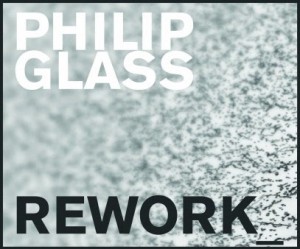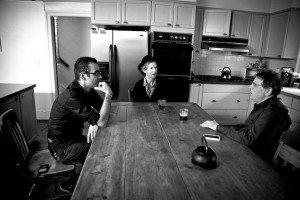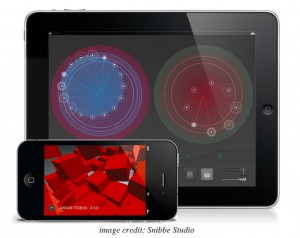Behind The Release: Philip Glass Rework
The year 2012 was a late-career landmark for Philip Glass.
In the beginning of the year, the composer celebrated his 75th birthday with the premiere of a new symphony and the first major production of his 1976 opera Einstein on the Beach in ten years.
By December, Beck had curated a new double-album worth of remixes titled Rework, and Scott Snibbe, the creator of Björk’s Biophilia app, developed a hotly anticipated custom program to go along with it.

Rework is out now.
Hector Castillo was charged with producing this new album of re-imagined Glass pieces. He and Glass’ label had tried a similar thing in 2005, but Castillo was never quite satisfied with Glasscuts, the collection of remixes that had been the result.
“But the idea stayed there,” Castillo told me when we met at Converse’s Rubber Tracks Studio, where he moonlights in the rotating cast of resident engineers. “I kept on bringing it up every year – ‘we should do this again, we should do this again!‘”
He may now be best known for his work with Brazilian Girls, but at the age of 14, Hector Castillo fell in love with Glass’ work when he saw the cult-classic film and tone poem, Koyaanisqatsi. A handful of years later he landed an internship at the composer’s Looking Glass recording studio in SoHo, quickly rising to become an assistant and then an engineer, and eventually taking over the B Room. He would work alongside Philip Glass for a decade.
Eventually, Glass was introduced to Beck, whose father had been a casual acquaintance in the New York art scene of the 70s, and Castillo got the second chance he had been lobbying for.
“He’s the sexy legs,” Castillo says of he post-modern pop star in a voice that betrays both genuine admiration and shrewd business sense. With Beck on board as curator, the project became an easy sell.
Assembling the Cast
The first step was for Beck, Glass and Castillo to get together and compile a list of artists and compositions they could draw on.
“Since I know the music well and since I recorded most of what we had available, I was able to guide some of the [remixers] toward stuff that might be cool for them to work on,” Castillo says. “But Beck, even better than I, understands which people have been influenced by Philip. He is such a musicologist and just knows so much in that way. He brought in [collaborators] who weren’t really on my radar, like Dan Deacon.”
“I mean, I had heard Dan,” Castillo says, but it was Beck who traced the line of influence and saw him as the natural fit he is. “He really understands who’s borrowed from Philip in the electronic music and remix worlds,” Castillo says, and this part of Beck’s influence is especially clear on the first half of the double album.
But as the first disc comes to a close, the album takes on a new life – one that showcases not the machine-like and sample-friendly side of Glass’ music, but its moody and meditative qualities.
On the final track of disc one, the Japanese artist and producer Cornelius “remixes” one of Glass’ most iconic pieces, the piano duet that opens Glassworks, by playing it live on an acoustic piano. Where many of the artists whose work appears on the first half of the album had requested 2-tracks or multitrack masters to create their remixes, Cornelius had begun his remix with a simple piano score.
Some started with even less than that. Jóhann Jóhannsson, for his remix of “Protest”, only requested access to a libretto, the Sanskrit text that Glass drew on when composing Satyagraha, his 1979 opera about the life and work of Mohandas Gandhi. Meanwhile, Peter Broderick of Efterklang takes an arpeggio written for a full symphony and re-appropriates it for acoustic guitar.
But for Castillo, the greatest standout may be Beck’s own remix, “NYC: 73-78”.
“It’s quite a trip,” he says. “[Beck] kind of goes through the whole Philip Glass career in his remix. The arc of it is really fantastic. And it pushes the limit of vinyl. It’s about 22-minutes and change.”
Adapting the App
When the production of Reworked began, there was no talk of an app. But Snibbe Studio caught wind of the project and became intent on getting involved.
Unlike with Biophilia, which was built from the ground up with an app in mind, Snibbe had to create an app for an album that was meant to be an entity unto itself. So instead of writing programs that would control the music, Snibbe focused on creating complimentary visuals, as so many have done for Glass’ work in the past, and allowed users to manipulate how those visual elements unfold.
To make this happen, Castillo and his team had to give Snibbe MIDI data that they could feed into their visualizers. Trevor Gureckis, Glass’ assistant and a member of the band My Great Ghost (whose own remix opens the album) listened through each track to create “miles” of MIDI transcription. Castillo would then take an additional pass with a MIDI joystick to add expression data.
Snibbe also built a virtual instrument featuring two graphical arpeggiators that can be made to play through some of the most recognizable of the Philip Glass “idioms”.
“It’s a lot of fun,” Castillo says. “Like all of Philip’s music, the album works really well with images. And the times I’ve listened to [Rework] since it’s been finished, I’ve listened to it on the iPad. You can just let it go in the background, and when you come back to it, you can focus on it, play with it, and interact.”
In the end, it’s fitting that Philip Glass, a composer who found his career collaborating with visualists and slicing up musical motifs, has given a new generation of artists and fans to do the very same with his own work.
But if you ask Philip Glass, Rework is far from the end. His newest opera, based on the final days of Walt Disney, premieres this week in Madrid.
Justin Colletti is a Brooklyn-based audio engineer, college professor, and journalist. He is a regular contributor to SonicScoop and edits the music blog Trust Me, I’m A Scientist.
Please note: When you buy products through links on this page, we may earn an affiliate commission.








